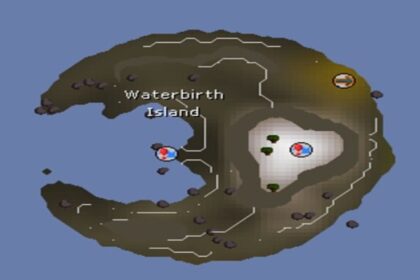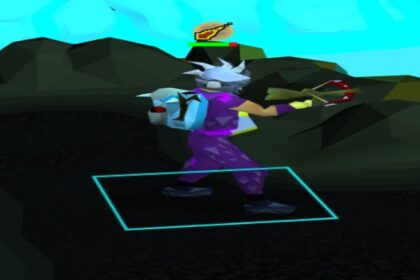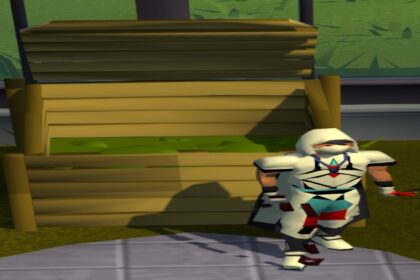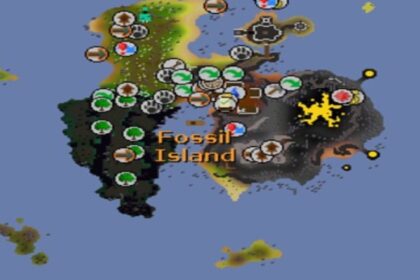Firemaking is one of those skills that embody the grind. Firemaking and Woodcutting often go hand in hand, but you can simply head to the Grand Exchange (GE) to purchase the logs you need if you’re only interested in leveling up firemaking.
You can choose to train firemaking and woodcutting at the same time by cutting trees and lighting the logs, or you can purchase the logs and just light fires. Efficient firemaking involves lighting logs consistently, which requires a lot of space.
Between each fire you light, your character will automatically move to another empty square to continue lighting from east to west. In this OSRS Firemaking Guide, we’ll discuss a few components that will affect how fast you gain XP.
Free-to-Play: Log Burning
There are several ways to train Firemaking. The first is simply to burn logs from your inventory. To do this, make sure you have these items in your inventory: Logs (the highest-tier logs you can burn at your skill level,) An axe (the highest-tier axe you can equip at your skill level) if you plan to source the logs yourself, and a tinderbox.
There are several places to do your OSRS firemaking training, but many players agree the Grand Exchange is best. There is a lot of free space there where you can burn logs one after the other in any formation (east to west, north to south…etc.). As well, you can store logs in note form in your inventory and use them on a banker whenever you need more logs.

If choosing to simply burn logs, burn regular logs until level 15, burn Oak logs until level 30, burn Willow logs until level 35 (if member) or 45 (if f2p). From here, members should burn Teaks until 42, then Arctic Pine until 45.
At 45, members and f2p players can burn Maple logs until 50. At 50, members can burn Mahogany until 60, while f2p must stick with Maple to 60. Both members and f2p can burn Yews at 60 until 75. F2p players will need to stick with yews until 99, while members can burn Magic logs from 75-90, then Redwoods from 90-99.
Normal logs can be burned from level 1 to level 15 firemaking, and they grant 40 experience per log. They can be cut from trees, dead and dying trees, and evergreen trees, which are some of the most common trees in OSRS and can be found everywhere.
To get from level 15 to level 30 firemaking, you need to be burning oak logs, which grant 60 experience per log. To cut oak trees, you’ll also need level 15 Woodcutting. ome of the best places to find a high number of oaks include the Varrock West Bank, Draynor Village, Lumbridge, and Falador.
The quickest way to get from level 30 to level 45 in the F2P world is by burning willow logs. To cut willow trees, you’ll need level 30 woodcutting. Some of the best places to find a high number of willows include southern Port Sarim, Rimmington, and the Lumbridge West farm.
To get from level 45 to 60, you’ll have to burn maple logs, which grant 135 experience per log. Maple trees require a Woodcutting level of 45. The best free area to cut maple logs is the Corsair Cove Resource Area in Feldip Hills. However, this requires you to have completed Dragon Slayer I.
The fastest way to get from level 60 to level 99 is by burning yew logs. Yew trees require level 60 woodcutting. As they play a big role in Farming and Fletching, yew logs are always in high demand and are very popular. They’ll always be readily available at the Grand Exchange, but they may be expensive.

There are plenty of places where you can find yew trees. Free areas with a high number of yew tree spawns include the area west of Lumbridge, south of Falador, and Rimmington. Additionally, one of the best places to cut yews is members-only.
However, there is an alternative, cheaper method to yew logs. If you’ve hit level 45 and don’t want to work with yew logs, burning maple logs is another method to get to level 99 firemaking. While burning yew logs gives 202.5 experience per log, they cost 160 GP each, compared to 9 GP each for maple logs which grant 135 experience per log.
Members: Pyre Logs
Being a member comes with many perks – more places to cut a variety of trees for logs, access to teleport tabs to get places faster, the ability to create pyre logs, and access to Wintertodt. This Members section of our OSRS firemaking guide will show you how to quickly make your way to level 99.
Creating pyre logs is the fastest way from level 1 to 30. This involves making/buying and using Sacred oil on logs to make Pyre logs. Players can make all types of pyre logs at level 1, but require a higher level to burn them. Since you avoid the high chance of failing to burn logs at lower levels, creating pyre logs means speeding up experience rates.
To make sacred oil, you’ll need to have rebuilt the temple during the Shades of Mort’ton quest. Purchase olive oil from Razmire Keelgan’s store in Mort’ton, light the altar in the center of the temple, and use their olive oil on the fire. This will convert the olive oil into sacred oil. Of course, you can also purchase sacred oil from the GE.

Each type of log requires a different number of sacred oil doses to become a pyre log. Regular and oak logs only require 2 doses (half a vial), Teak, Arctic, Maple, and Mahogany require 3 doses, and yew logs or above require 4 doses (a full vial).
Once you achieve level 30, the fastest Firemaking experience is gained the same way as free-to-play players: burning the highest-tier log possible. Players can refer to the table in the free-to-play section for guidelines.
Members: Wintertodt
From level 50, there is another alternative to burning logs that is faster and more profitable, but higher effort than burning logs: subduing Wintertodt. Wintertodt is a minigame-style boss that is fought using skills instead of combat.You can find it in the Northern Tundras in Great Kourend.

Wintertodt can be fought solo or in groups of varying sizes. For fast Firemaking experience, log into one of the official Wintertodt worlds (307, 309, 311, 389) for games lasting around four minutes. If you were to solo, which is doable, games would take around 45 minutes.
You’re awarded an amount of firemaking experience based on your level at the end of each fight, so faster fights mean faster experience. On these mass worlds, you can get hundreds of thousands of experience points per hour, just from casual play. That is insane.
Wintertodt: Overview
Upon arrival, you’ll likely see a horde of players subduing Wintertodt. Note that you CAN take damage when subduing Wintertodt, and dying here is unsafe, as the normal rules for loss of items apply and Hardcore Ironmen lose their Hardcore status.
During the fight, Wintertodt will constantly damage you for a percentage of your HP. This is why many players recommend grinding Wintertodt with a lower HP level, since this minimizes damage taken.
Another way to mitigate the damage taken includes wearing four pieces of warm clothing. Many players opt to wear the Pyromancer Set, but this drops from Wintertodt. If you don’t have it, you can dig up the Clue Hunter Outfit, buried on specific tiles of the OSRS map.

Other sets of warm clothing include the bomber hat and jacket from the Enlightened Journey quest, all parts of the Santa, AntiSanta, and Bunny outfits from Holiday events, and yak-hide armor.
Whilst at Wintertodt, it is also useful to wear a Hitpoint cape (if you have one) and a regen bracelet to lessen the damage from the cold and use the Redemption prayer. This way, players are less likely to need food to heal.
You will need food or some other method of restoring your HP during the Wintertodt fight, but all the other items you’ll need are provided in the starting area. There are axes for chopping roots, knives for fletching them, tinderboxes to start the braziers, and vials to make the Pyromancer-healing potions.

If you have access to them, I would recommend using Saradomin Brews as your healing item of choice. These are potions that restore a HP based on your Hitpoint level, and typically contain four doses. This way, you pack more healing ability into your limited inventory slots.
However, the Saradomin Brews lower combat stats when sipped. While this doesn’t matter at Wintertodt, since none of these stats are used, it’s important to remember.
It may be prudent to teleport to your player-owned house with an ornate rejuvenation pool, the Ferox Enclave, or the Elidinis Statue in the desert to restore these stats between each fight.
Wintertodt: the Fight

Once the round starts, light a brazier, chop Bruma roots until your inventory is full, and burn them in the brazier. Fix (with a hammer) and relight the brazier if needed.

Note that equipping a full pyromancer outfit also increases Firemaking experience by 2.5% (pieces of the outfit can be found by searching supply crafts immediately after subduing the Wintertodt).
Experience rates will differ depending on your level. It will take around 600 rounds and 40 hours (assume an average kill length of 4 minutes and a 1-minute pause) to get from level 50 to level 99 Firemaking if you fletch every log.
Extra Firemaking Information
There are also several quests that reward firemaking experience, though none of them are free-to-play. These quests include The Giant Dwarf, Heroes’ Quest, Enlightened Journey, Making Friends with My Arm, and Enakhra’s Lament.
Once you’ve reached 99 firemaking, you can buy “The cape worn by master firelighters,” the firemaking cape, for 99,000 coins along with the Firemaking hood from Ignatius Vulcan, just south of Seers’ Village. It can act as warm clothing for Wintertodt and as an inextinguishable light source when worn or in your inventory.
Final Thoughts
While it doesn’t have as many uses as other skills, firemaking can be an incredibly fast and profitable skill to train via unique methods like Wintertodt. In fact, the experience offered by simple casual play at Wintertodt is some of the best in the game.






